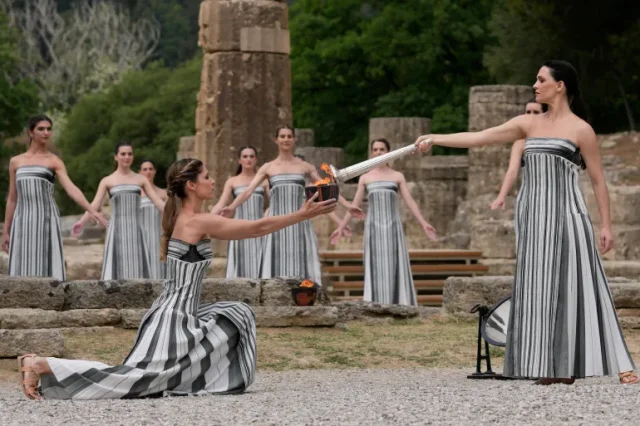The torch for the Paris Olympics 2024 was set off in ancient Olympia, the birthplace of the ancient Games, marking the final stretch of the seven-year preparations for this edition of the Games.
Greek actress Mary Mina, playing the role of high priestess, lit the torch for Paris Olympics 2024 using a backup flame instead of a parabolic mirror due to cloudy skies. The flame was lit in a rehearsal in the 2,600-year-old Temple of Hera, near the stadium where the Olympics were born in 776 BC.
Carrying the flame in a pot, Greek actress Mary Mina lit the torch for the first bearer, 2020 Olympic rowing champion Stefanos Ntouskos. Retired swimmer Laure Manaudou, who won a gold medal at the 2004 Athens Olympics, followed as France’s first torchbearer in Olympia.
“The Olympic flame that we are lighting today symbolises this hope for a better future,” said International Olympic Committee President Thomas Bach.
In ancient Greece, when the Olympics was held at Olympia, a sacred fire was kept burning throughout the entire sporting celebration. The tradition was officially revived in Berlin Olympics 1936. On the 20th of July 1936, amidst the ruins in front of the altar of Hera at Olympia, the Olympic flame was lit naturally from a parabolic mirror reflecting the bright Sun rays.
The flame, after an 11-day relay across Greece, will be officially handed over to Paris Games organisers in Athens’s Panathenaic Stadium, the site of the first Modern Games, on April 26. During the 11-day relay of the torch for Paris Olympics 2024 on Greek soil, some 600 torchbearers will carry the flame over a distance of 5,000 kilometres through 41 municipalities.
It will then depart for France on board a three-masted ship, the Belem, which will arrive in Marseille on May 8. The French torch relay will last 68 days and will end in Paris with the lighting of the Olympic flame on July 26.




